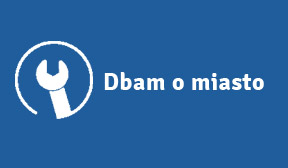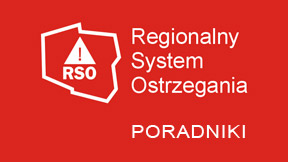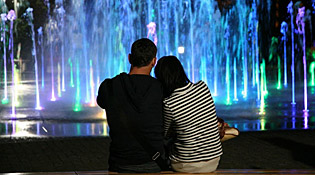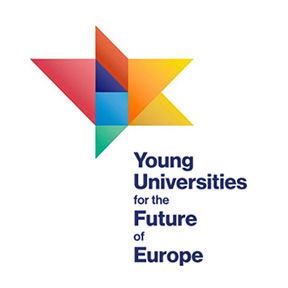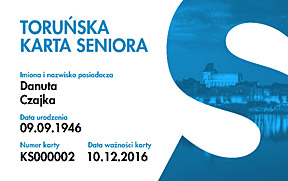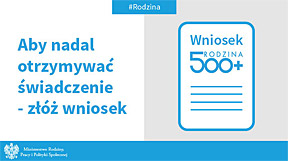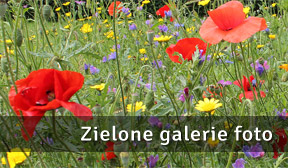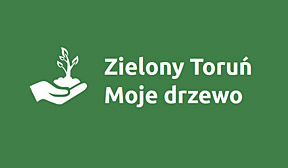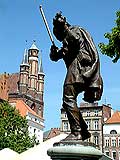Raftsman of Toruń
Because of its location on the Vistula river, border-city character, and relations with numerous cities of our continent, Toruń from the beginning of its existence in the 13th century has played an important role in European trade. Part of the commercial profile of the city is its rafting tradition.
Even today one of the most famous legends of Toruń reminds the city of this tradition. According to legend, a raftsman playing the violin managed to lead thousands of frogs away from the city during a calamity of these amphibians. In honour of this hero a monument of the raftsman was erected in Toruń in 1914. Today the fountain–monument of the raftsman of Toruń surrounded by a herd of frogs stands near the south-west corner of the Old Town Hall.
Toruń - the historic centre of Polish rafting
In the Middle Ages, Toruń played the role of a storage city perfectly. Active exchange with European Hanseatic cities assured delivery of overseas goods to the city, which reached the city mostly by the Vistula river from Gdańsk. The Polish merchants, on the other hand, delivered mostly wood, cereals and skins to Toruń. Due to the fact that in the 14th century the city obtained the right of storage, the merchants laid out their goods in Toruń for 5 days. Later this privilege was taken over by Gdańsk, but Toruń still played the role of a mediator in the trade of goods floated on the Vistula river from the south of Poland well. The importance of the city resulted from the fact that it possessed a strategic bridge across the Vistula river and from the location on the water route reaching even Włodzimierz Wołyński.
Rafting traditions were connected with the commercial character of the city. Originally, trade meant inland navigation on ships and boats. Therefore, raftsmen were merchants who used these means of transport. Parallel to the rafting tradition in Toruń, the floating of timber tied into rafts developed. This was a so-called ‘orylka’ (float), and the people involved in it were called ‘oryle’ (floaters). The rafting of wood on the river was so important a branch of the Teutonic, Polish and Prussian trade that it remained in our city until World War II.
The quantity of the wood that passed near the city through the Vistula river was enormous. In 1903, a port for reloading and storing wood was built on the bank of the Vistula in Toruń. It’s surface had 66 ha (one could keep 110 thousand cubic metres of wood on it). The wood floated by raftsmen was transported at different times in the northern or western direction. Therefore, it reached not only Gdańsk, because in the 19th century, when the Bydgoszcz Canal was built, Toruń became part of the Prussian water system which allowed rafting timber to Szczecin, and later to Berlin. It is estimated that the rafting transport of wood on the Vistula river through Toruń reached its highest levels between the years 1910 and 1912 during World War I.
Because the main customs office operated in Toruń since 1826, the raftsmen had to stop in the city to anticipate acceptance and the imposition of duty on their goods. This led to the crystallization of raftsmen’s folklore within the borders of the city. Raftsmen became numerous and visible guests of the city which was the destination of their long river trips from the lands annexed by Russia and Austria. The timber delivered by raftsmen from these lands to the timber-port of Toruń was taken over by the local raftsmen. It reached Toruń from regions situated not only on the Vistula river, but also on the Bug, the Narew, the Drwęca, the San or the little Tanwia in Małopolska, on which the village Ulanów, famous for delivering the best Polish raftsmen.
The raftsmen of the surroundings of Toruń who engaged in rafting usually lived in nearby Złotoria and Kaszczorek. Both villages were next to the outlet of the Drwęca into the Vistula and this was decisive for their role in the rafting trade (in Złotoria the duty was collected at the customs chamber already in the 14th century). The raftsmen of Toruń lived predominantly in the district Rybaki that was situated on the Vistula.
The rafting of timber over a long distance was a difficult task. The raftsmen joined 8-12 logs of timber into so-called boards or tiles. Their width was adapted to the river on which the boards were to be transported. The Vistula boards were up to 5-10 m in width. They were joined by transverse logs called "klistry". The row of joint boards (the so-called belt) could have been even 120 m long. The Vistula allowed the joining of belts in breadth and therefore it was possible for gigantic sets of belts even 60 m wide to appear on the river. At the front of the belt there was the head, the last raft was called "col". The floated timber was generally called a "las". And Toruń was for many raftsmen a "pal" that is the destination of the raft. The chief of one transport was called a "retman" and commanded a group of raftsmen. Because the rafting of one transport of timber often lasted a very long time, the raftsmen built on their belts straw roofs and sleeping sheds. Rafting could take place from the early spring, when the Vistula freed itself from the winter ice float, and it could finish in late autumn.
Apart of the Toruń rafting tradition was the well-deserved rest in the town of Copernicus of the crews after a stay on the river that lasted a few weeks. The ceremonies of fitting young fledglings for true rafters usually took place in Toruń. A place of their traditional meetings was the non-existent raftsmen's pub „Under the Turk” in the Old-Town Market Square. From the moment of the erection of the monument of Nicholas Copernicus in the Toruń Market Square in 1853, it became a meeting place and a rest site for the raftsmen.
Najczęściej czytane aktualności
-
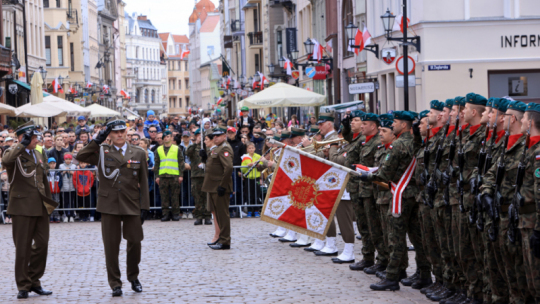 Kultura, MiastoW ramach niezwykłej majówki na Rynku Staromiejskim odbędą się plenerowe koncerty, kolejna edycja Święta Tańca, spektakle, warsztaty i uroczystości państwowe. To wszystko oraz wiele innych atrakcji czeka na mieszkańców i turystów podczas tegorocznej majówki w Toruniu, która odbędzie się od 30 kwietnia do 5 maja 2024 r., pod hasłem #zażywajkultury!...
Kultura, MiastoW ramach niezwykłej majówki na Rynku Staromiejskim odbędą się plenerowe koncerty, kolejna edycja Święta Tańca, spektakle, warsztaty i uroczystości państwowe. To wszystko oraz wiele innych atrakcji czeka na mieszkańców i turystów podczas tegorocznej majówki w Toruniu, która odbędzie się od 30 kwietnia do 5 maja 2024 r., pod hasłem #zażywajkultury!... -
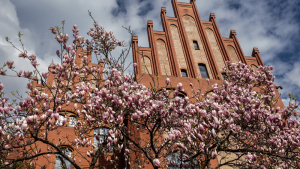 Kultura, Miasto, SportW ostatni weekend kwietnia, oprócz pięknej pogody, spodziewamy się wielu fantastycznych wydarzeń kulturalnych, rekreacyjnych i sportowych. Taka rozgrzewka przed majówką. Zapraszamy!
Kultura, Miasto, SportW ostatni weekend kwietnia, oprócz pięknej pogody, spodziewamy się wielu fantastycznych wydarzeń kulturalnych, rekreacyjnych i sportowych. Taka rozgrzewka przed majówką. Zapraszamy! -
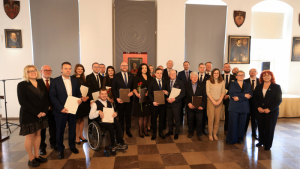 MiastoW czwartek 25 kwietnia 2024 r. w Sali Mieszczańskiej Ratusza Staromiejskiego odbyło się uroczyste wręczenie zaświadczeń o wyborze na Prezydenta Miasta Torunia i radnych Rady Miasta Torunia kadencji 2024-2029.
MiastoW czwartek 25 kwietnia 2024 r. w Sali Mieszczańskiej Ratusza Staromiejskiego odbyło się uroczyste wręczenie zaświadczeń o wyborze na Prezydenta Miasta Torunia i radnych Rady Miasta Torunia kadencji 2024-2029. -
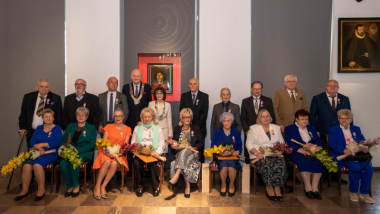 MiastoW Ratuszu Staromiejskim w Toruniu 9 toruńskich par odebrało Medale za Długoletnie Pożycie Małżeńskie. Uroczystość odbyła się 26 kwietnia 2024 r.
MiastoW Ratuszu Staromiejskim w Toruniu 9 toruńskich par odebrało Medale za Długoletnie Pożycie Małżeńskie. Uroczystość odbyła się 26 kwietnia 2024 r. -
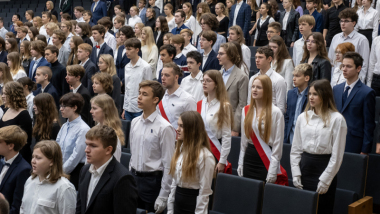 Miasto26 kwietnia 2024 r. uczniowie najstarszych klas szkół średnich uroczyście kończą zajęcia szkolne. Z tej okazji swoje słowa kieruje do nich prezydent Michał Zaleski.
Miasto26 kwietnia 2024 r. uczniowie najstarszych klas szkół średnich uroczyście kończą zajęcia szkolne. Z tej okazji swoje słowa kieruje do nich prezydent Michał Zaleski. -
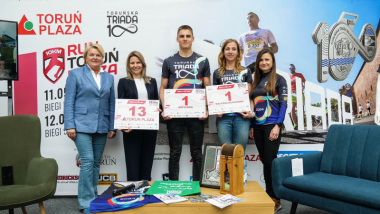 Miasto, SportNajwiększa impreza biegowa w regionie RUN TORUŃ odbędzie się już po raz trzynasty, a od pierwszej edycji jej istnienia wydarzenie to współtworzy galeria handlowa Toruń PLAZA. To zdecydowanie dowód na zaangażowanie społeczne i korporacyjne toruńskiej galerii w promocję zdrowego stylu życia oraz aktywności fizycznej. Podczas tegorocznej edycji...
Miasto, SportNajwiększa impreza biegowa w regionie RUN TORUŃ odbędzie się już po raz trzynasty, a od pierwszej edycji jej istnienia wydarzenie to współtworzy galeria handlowa Toruń PLAZA. To zdecydowanie dowód na zaangażowanie społeczne i korporacyjne toruńskiej galerii w promocję zdrowego stylu życia oraz aktywności fizycznej. Podczas tegorocznej edycji...
-
W ostatni weekend kwietnia, oprócz pięknej pogody, spodziewamy się wielu fantastycznych wydarzeń kulturalnych, rekreacyjnych i sportowych. Taka rozgrzewka przed majówką. Zapraszamy!
-
Przed nami Święto Flagi i oraz 223. rocznica uchwalenia Konstytucji 3 Maja. Warto sprawdzić, co będzie się działo w Toruniu w dniach 2-3 maja.
-
W niedzielę 9 czerwca 2024 roku odbędą się wybory do Parlamentu Europejskiego. Lokale wyborcze w Toruniu będą czynne w godzinach 7:00-21:00. Publikujemy ważne informacje związane z wyborami.
-
Z okazji Święta Konstytucji 3 Maja w piątek 3 maja 2024 r. na tory wyruszy Muzyczny Tramwaj Probaltiki.
-
Od środy 1 maja 2024 r. wprowadzone zostaną korekty rozkładów jazdy linii nr 12, 14, 28 oraz 31.
-
W piątek, 3 maja 2024 r., w związku z zawodami żużlowymi na Motoarenie, uruchomione zostaną dodatkowe kursy tramwajów.
-
26 kwietnia 2024 r. uczniowie najstarszych klas szkół średnich uroczyście kończą zajęcia szkolne. Z tej okazji swoje słowa kieruje do nich prezydent Michał Zaleski.
-
W czwartek 25 kwietnia 2024 r. w Sali Mieszczańskiej Ratusza Staromiejskiego odbyło się uroczyste wręczenie zaświadczeń o wyborze na Prezydenta Miasta Torunia i radnych Rady Miasta Torunia kadencji 2024-2029.


